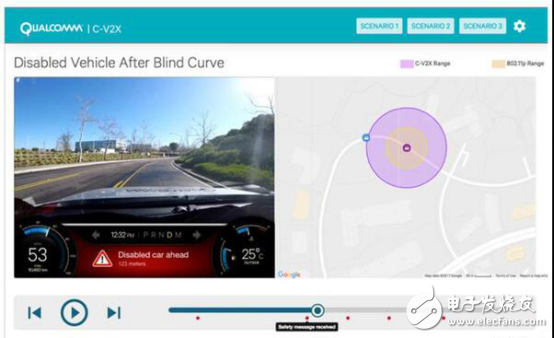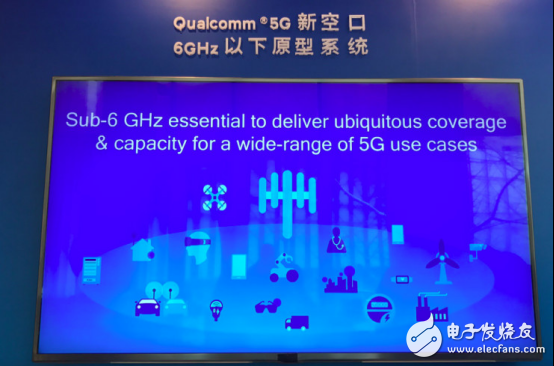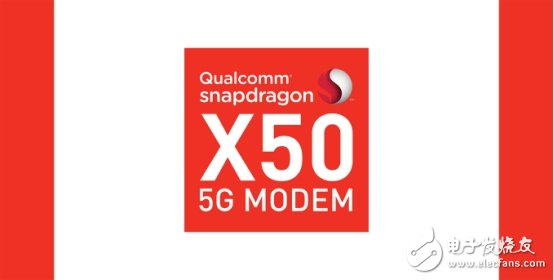At this year's MWC2017 Barcelona, ​​chip giant Qualcomm demonstrated a number of latest research and development achievements on 5G technology. As a grand event in the communications industry, a new generation of network technology represented by 5G has set off a new trend, operators and communications across the country. Equipment vendors and chip vendors have launched their latest products with 5G technology. Qualcomm is also leading the way in 5G technology, as well as automotive, computing, Internet of Things, health care, data center and other industries, as well as millions of terminal equipment interconnection technologies. It provides a lot of finished products and technologies for the development of 5G standardization, 5G modem, automotive V2X communication, VR virtual reality development and other series for the future 5G development.
Accurately locate high-definition maps for autonomous drivingIn cooperation with TomTom, the world's leading navigation and mapping company, Qualcomm uses its own driving data platform, combined with TomTom's original high-definition map resources, to achieve automatic positioning of cars in high-speed driving to accurately locate their position and help decide which driving route to use.

The Qualcomm Driving Data Platform utilizes a number of cutting-edge technologies to intelligently capture and analyze data from different vehicle sensors to make the vehicle smarter: determine its location, monitor and learn driving patterns, sense the surrounding environment and reliably and accurately perceive the information The world shares.
The Qualcomm driving data platform uses the Qualcomm® SnapdragonTM 820Am automotive processor. Leveraging the precision positioning, in-vehicle machine learning, heterogeneous computing and connectivity capabilities of the Qualcomm driving data platform, TomTom and Qualcomm Technologies aim to add improved, scalable and cost-effective crowdsourcing models to high-definition mapping methods. . The new concept supports massively connected cars to “see†and “understand†the environment, traffic and road conditions they are in, and to support real-time information entry for maps and road updates.
High-performance, highly accurate and frequently updated HD maps are critical to supporting the most cutting-edge applications envisioned by the automotive industry, especially for autonomous driving. On the build cloud platform, high-definition maps can be drawn and maintained, and the platform will utilize a range of sources of information, including crowdsourced data from a large number of smart connected cars.
The Qualcomm Driving Data Platform is a low-cost, easy-to-integrate map mapping solution for autonomous vehicles. Several of these key technologies are integrated into cost-effective edge computing solutions, which are essential for supporting safer, more connected and smarter traffic.
Qualcomm implements multiple functions of C-V2X technology for 5G evolution. 1 Multiple C-V2X direct-link technology use cases
In the real-world use case test of the car network, the use case for C-V2X technology is the “see-through†use case between two connected cars on the road, and the real-time notification of the emergency vehicle approaching when the emergency vehicle approaches. "Example.
The above two use cases are currently being developed and tested in the trial network, using lower latency and high throughput performance to achieve high-resolution video streaming between the two cars through the C-V2X network function, demonstrating its responsiveness. And real-time event notifications.
Qualcomm works with PSA Peugeot Citroen, Orange and Ericsson to deliver C-V2X technology in R14 and its powerful evolution towards 5G through network-based communications and direct communications, enabling greater security, greater connectivity and more The shared vision of intelligent transportation.
The C-V2X technology defined in the 3GPP Release 14 specification is expected to support security and other enhanced use cases. Subsequent versions of the 3GPP specification, including the 5G new air interface, are expected to evolve network and direct communication to support front-end use cases and enable autonomous driving.
2 Qualcomm's next-generation wireless technology automotive 5G and C-V2X solutionsIt is understood that Qualcomm and LG have passed a number of technical tests and will launch a new generation of wireless technology in the first half of 2018.

LG develops advanced vehicle networking solutions based on Qualcomm Technologies' connected car platform that supports Gigabit LTE speeds with Qualcomm® X16 LTE modems and complements the QCA65x4 Wi-Fi 802.11ac solution. The platform also supports 802.11p/DSRC and C-V2X technology based on the 3GPP Release 14 specification.
The advanced wireless capabilities of 5G and C-V2X technologies will support a variety of new use cases that are necessary to achieve a more connected and more automated automotive vision.
C-V2X technology is a key feature of automotive safety solutions and autonomous driving solutions with a strong 5G evolution path. The C-V2X complements other advanced driver assistance systems (ADAS) sensors such as cameras, radars and lidars to provide information in the surrounding environment, even in non-line of sight (NLOS) scenarios. In addition to supporting 360-degree non-line-of-sight, the C-V2X also supports enhanced context awareness, which detects and utilizes direct communication over the 5.9 GHz ITS band to exchange information with other vehicles, infrastructure, and pedestrian terminals, as well as commercial The cellular technology band communicates with the cloud service. Compared to current technologies, the C-V2X extends the distance of V2X direct communication, improves reliability, reduces latency, and provides superior non-line-of-sight performance. Based on the 3GPP Release 14 specification, this technology has been widely supported by the ecosystem and is expected to be tested this year.
Wireless communication provides data to the vehicle that is truly complementary to the information provided by other sensors. Taking the C-V2X as an example, the technology and its evolution towards 5G can help the car identify the surrounding environment. A pedestrian or a car can be detected by a pedestrian's smartphone, even if they are being built by the building. Or other large cars are blocked.
In the process of C-V2X evolution to 5G, it can provide more wireless communication functions for autonomous vehicles to support a variety of leading edge use cases, such as high-throughput sensor data and map sharing between vehicles, capturing information from vehicle cameras. Streaming to other vehicles for "see-through" functionality, or enabling broadband ranging to improve location services; at the same time, it will also be backward compatible with 3GPP Rel. 14 C-V2X technology. The 5G is capable of supporting ultra-high-speed and massive nodes of several gigabits per second, and supports mission-critical services through ultra-reliable, low-latency communications, which will provide a unified connectivity platform for autonomous vehicles that are always connected in the future.
Qualcomm develops 5G new air interface specification based on 3GPPIt is reported that Qualcomm and Vodafone are jointly conducting 5G interoperability testing based on 5G new air interface (5G NR) and conducting OTA field test. Currently, 3GPP is formulating 5G new air interface specification.

The trial aims to promote the mobile ecosystem's verification of 5G new air interface technology and support operators to test 5G new air interface network infrastructure and terminals in line with 3GPP standards. The trial focused on a number of 5G new air interface technologies that utilize large bandwidth to increase network capacity and achieve data rates of several gigabits per second.
The new 5G new air interface technology utilizes the existing licensed frequency band below 6 GHz and the new frequency band. The large bandwidth available in the high frequency band can increase the network capacity and support data transmission rates of up to several gigabits per second. 5G is critical to meeting the growing demand for consumer connectivity, supporting emerging consumer mobile broadband experiences such as virtual reality, augmented reality and networked cloud services.
The trial will leverage 5G system solutions and terminals from Ericsson and Qualcomm Technologies to demonstrate real-world usage scenarios and deployment scenarios covering a wide range of use cases.
The 5G standard demonstration based on the frequency band below 6 GHz is an important step in the development of 5G. Standardization of this technology will enable 5G mobile networks with high performance and reliability to support global coverage.
In addition, the trial will use a number of advanced 3GPP 5G new air interface technologies, including large-scale multi-input multi-output (Massive MIMO) antenna technology, adaptive self-contained TDD transmission, beamforming technology, OFDM-based scalable waveforms to support more Large bandwidth, advanced coding and modulation schemes, and a new flexible frame design.
The non-independent 5G new air interface will leverage the existing LTE wireless and evolved packet core network as the backbone of mobility management and network coverage, while adding a new 5G wireless access carrier.
The above interoperability testing and testing based on the 3GPP 5G new air interface standard will be launched in the second half of 2017 and will comply with the relevant resolutions of the 3GPP Release 15 specification.
3GPP 5G new air interface specification technical analysis:
The first 3GPP 5G new air interface specification will be part of Release 15. The 5G new air interface is the global 5G standard and will utilize the frequency band below 6 GHz and the millimeter wave band.
Qualcomm Gigabit LTE commercial chip for LAA supportAt the MWC booth, Qualcomm demonstrated Gigabit LTE using Granted Assisted Access (LAA) technology. The data transmission rate is greatly improved by using the unlicensed spectrum and the licensed spectrum simultaneously by the LAA.
The demonstration achieves a 1Gbps rate by aggregating bands up to 80 MHz on licensed and unlicensed bands and using a mobile test terminal integrated with X16 LTE's Qualcomm® SnapdragonTM 835 processor. With the support of the "Listen Before Talk (LBT)" mechanism defined by the European Telecommunications Standards Institute (ETSI), fair system coexistence can be achieved by different system operations on the same unlicensed band.

The company achieves theoretical peak rates of up to 1 Gbps through the deployment of small base stations and the use of technologies such as carrier aggregation and LTE Authorized Access (LAA).
The LAA feature provides the reliability and seamless mobility of LTE-licensed spectrum and enables a significant increase in throughput through the use of unlicensed spectrum. For some deployment scenarios (eg, next-generation small base stations in high-use areas), it will be a promising solution.
By leveraging the LAA, users will be able to enjoy a better LTE experience as unlicensed spectrum can be used to increase data rates. LTE and Wi-Fi users will coexist fairly in unlicensed bands, and end users will benefit both indoors and outdoors.
Qualcomm expands X50 5G modem for mobile, conforms to 3GPP 5G new air interface standard
Qualcomm said at the Barcelona show that the company is expanding its Qualcomm® X50 5G modem family to support the 5G new air interface multimode chipset solution for 3GPP 5G new air interface (5G NR) global systems.
The new modem supports operation below 6 GHz and multi-band millimeter-wave spectrum, designed to provide a unified 5G design for all major spectrum types and bands, while addressing a wide range of usage scenarios and deployment scenarios.
The Snapdragon X50 5G modem family is designed for enhanced mobile broadband to provide wider bandwidth and ultra-high speed. In addition, the modem solution is designed to support both Non-Standalone (NSA) operation (transmission of control signaling over LTE) and Standalone (SA) operation (send all control signaling and user data via 5G new air interface) And designed to support the next generation of top-of-the-line mobile cellular terminals and assist operators in conducting early 5G trials and deployments. Commercial products integrating 5G new air interface modems from the Opteron X50 series are expected to be available from 2019, supporting the first large-scale 5G new air interface test and commercial network release.
The new product of the Snapdragon X50 5G modem series is designed to support 2G/3G/4G/5G multi-mode functions on a single chip, providing strong mobile performance through simultaneous connection of 4G and 5G networks. The single-chip solution also integrates with Gigabit-class LTE capabilities led by Qualcomm Technologies. As a high-speed overlay network that coexists and interacts with earlier 5G networks, Gigabit LTE is an important pillar of the 5G mobile experience. This series of advanced multi-mode features are designed to provide gigabit connectivity, a key requirement for next-generation top smartphones and mobile computing.
The expanded Snapdragon X50 5G modem family builds on the technological leadership of Qualcomm Technologies' 5G new airspace prototype system and joint testing and testing with leading network operators and network terminal vendors. The recently announced 5G new air interface connection based on the 3GPP standard for Qualcomm Technologies' 5G new air interface prototype below 6GHz demonstrates some of the key technology and system design principles in the future 5G new air interface system and specification, such as Orthogonal Frequency Division Multiplexing (OFDM)-based scalable waveforms supporting multi-bandwidth, reciprocity-based multi-user multiple-input multiple-output (MIMO), advanced LDPC channel coding, adaptive independent TDD subframes, and New flexible low latency slot structure and more.
The Snapdragon X50 5G modem family builds on Qualcomm Technologies' next-generation wireless technology development, promotion, and advancement of the 3GPP standardization process. As Qualcomm Technologies does on 3G, 4G and Gigabit LTE, the company is working with leading network operators to ensure the standardization of 3GPP 5G new airspace and the timely commercial deployment of 5G new airspace. The Snapdragon X50 5G series is designed to support the new 5G air interface features, bringing networking, mobile, and broadband applications such as virtual reality, augmented reality and networked cloud computing to new heights.
Aquarium Frequency Pumps,Mute Self-Frequency Pump,Energy-Saving Frequency Pumps,Large Flow Pond Pump
Sensen Group Co., Ltd.  , https://www.sunsunaquariums.com